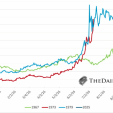Gold price signals slow rebound as merger activity picks up
Toronto-Canada (Jun 24) The global gold mining industry is showing signs of life as merger activity picks up and industry veterans set up new companies and hunt for projects, taking advantage of weak prices to lay the groundwork for a rebound.
Almost four years after the price of gold began tumbling, cash-starved and debt-ridden miners are selling, merging or closing shop, pushing the value of completed gold mining mergers and acquisitions in the first five months of this year to $3bn, twice that in the same period last year, according to Thomson Reuters GFMS, a metals research consultancy.
At the same time, with stock markets near record highs, some fund managers are examining the sector.
In the first quarter, Paris-based asset manager Carmignac Gestion bought 11.65-million shares of Goldcorp, the highest-valued gold mining company, making it the Vancouver-based miner’s eighth-biggest shareholder, Thomson Reuters data shows.
"The perception that mining equities show good value is starting to spread," said Hedley Widdup, a fund manager at Melbourne-based Lion Selection Group, which invests in small mining companies and explorers.
To be sure, no one is expecting an overnight resurgence and signs of pain are still widely visible — in bankruptcy filings, job cuts and an industry preoccupation with reducing costs.
And though the gold price is not forecast to recover this year, a rebound could start next year, albeit slowly.
GFMS is forecasting an average price of $1,170/oz this year, below the current $1,185/oz, and $1,250/oz for next year.
"We felt that finally it looked as though you might be able to pick up projects," said Marc Prefontaine, CEO of Canadian gold miner Orla Mining, which started operations this month.
He did not know when the gold market would rebound, he said, "but we just felt it was not going any lower".
Mr Prefontaine, who was CEO of Grayd Resources before it was sold to Agnico-Eagle Mines in 2011, said conditions are good for a full-time return to the industry. Helping fuel optimism for a revival is the return to the sector of generalist investors, money managers whose focus is not exclusively on gold mining companies.
Their flight from the mining sector helped fuel a 36% collapse in the market value of the top 40 global miners between 2012 and end-2014, PwC data shows.
"There has been more interest from generalists at the broker conferences for meetings," said David Harquail, CE of gold royalty firm Franco-Nevada. "Often these generalists have no positions in the gold sector."
Nongold-focused mutual funds nearly doubled the number of shares they hold in 11 of the world’s biggest gold miners in the first five months of this year, according to data from Thomson Reuters’ Lipper service.
The number of funds holding gold shares also increased.
South African-based Investec fund manager Hanré Rossouw said that he had been debating whether now was the right time to invest again in mining shares. "I don’t think commodity prices are going to dramatically go up from here but I do think that the individual companies’ ability to cut costs will differentiate their performance," he said.
In the gold sector, he favours AngloGold Ashanti.
A few large generalists had come on to Kinross Gold’s share register in recent months, said Andrea Mandel-Campbell, a spokeswoman for the world’s seventh-biggest gold producer. She declined to name them.
"There is recognition that there is value in the sector and the market is starting to sense that the companies are better managed now," said Joseph Forster, portfolio manager at Van Eck, which is one of the biggest shareholders in the gold mining sectors.
A number of assets put up for sale, including Barrick Gold’s Australasian assets, have drawn multiple offers, a potential sign of better days ahead.
"The fact that a number of companies are potentially fighting for an asset in the gold sector at this time, let’s face it, is positive," said Douglas Forster, CE of Canada-based Newmarket Gold, which last month unveiled a $190m merger. Newmarket is backed by Lukas Lundin and Randall Oliphant, gold mining industry veterans.
For others, the signals for getting back into the mining sector — stronger demand, weaker supply and specifically for gold, a weaker US dollar — are not yet evident.
"I’m not really bearish but I don’t see the trigger yet to get really bullish.
"As a result I am still more on the cautious side and that’s why we have very slim holdings right now," said Darren Lekkerkerker, a portfolio manager for Fidelity Investments in Toronto.
Source: Reuters












